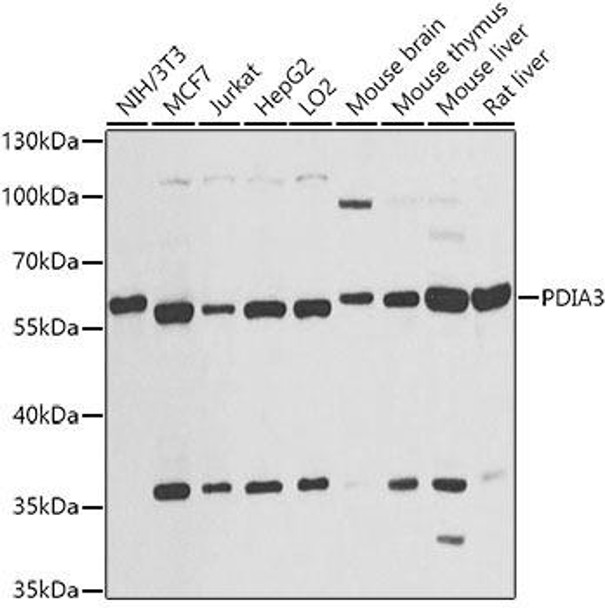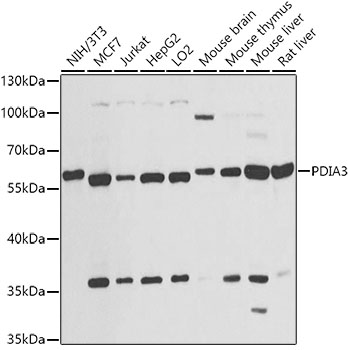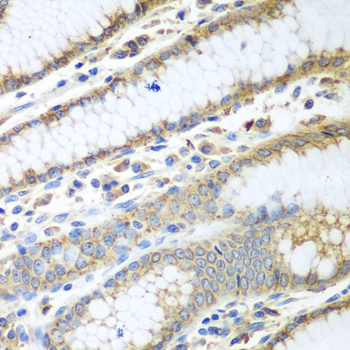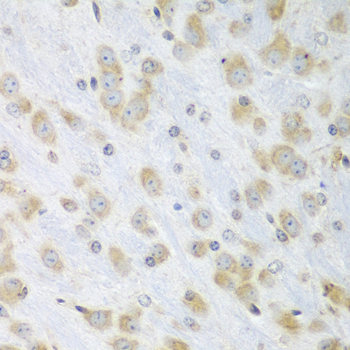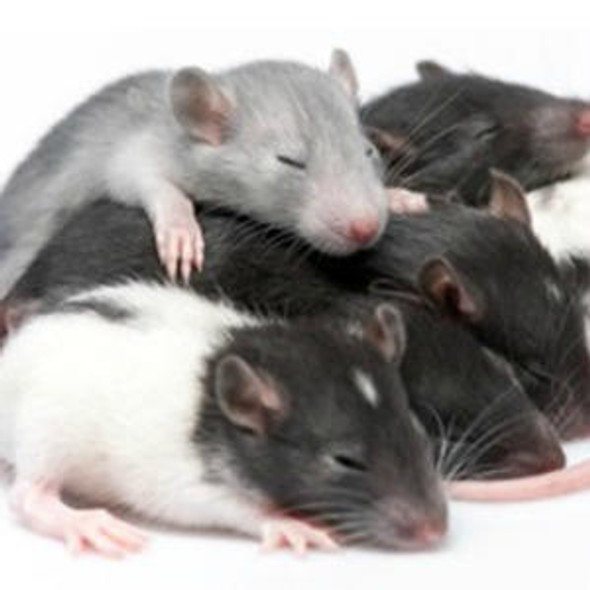Anti-PDIA3 Antibody (CAB1085)
- SKU:
- CAB1085
- Product type:
- Antibody
- Reactivity:
- Human
- Mouse
- Rat
- Host Species:
- Rabbit
- Isotype:
- IgG
- Antibody Type:
- Polyclonal Antibody
- Research Area:
- Cell Biology
Description
| Antibody Name: | Anti-PDIA3 Antibody |
| Antibody SKU: | CAB1085 |
| Antibody Size: | 20uL, 50uL, 100uL |
| Application: | WB IHC IF |
| Reactivity: | Human, Mouse, Rat |
| Host Species: | Rabbit |
| Immunogen: | Recombinant fusion protein containing a sequence corresponding to amino acids 206-505 of human PDIA3 (NP_005304.3). |
| Application: | WB IHC IF |
| Recommended Dilution: | WB 1:500 - 1:2000 IHC 1:50 - 1:100 IF 1:50 - 1:100 |
| Reactivity: | Human, Mouse, Rat |
| Positive Samples: | NIH/3T3, MCF7, Jurkat, HepG2, LO2, Mouse brain, Mouse thymus, Mouse liver, Rat liver |
| Immunogen: | Recombinant fusion protein containing a sequence corresponding to amino acids 206-505 of human PDIA3 (NP_005304.3). |
| Purification Method: | Affinity purification |
| Storage Buffer: | Store at -20°C. Avoid freeze / thaw cycles. Buffer: PBS with 0.02% sodium azide, 50% glycerol, pH7.3. |
| Isotype: | IgG |
| Sequence: | FRPS HLTN KFED KTVA YTEQ KMTS GKIK KFIQ ENIF GICP HMTE DNKD LIQG KDLL IAYY DVDY EKNA KGSN YWRN RVMM VAKK FLDA GHKL NFAV ASRK TFSH ELSD FGLE STAG EIPV VAIR TAKG EKFV MQEE FSRD GKAL ERFL QDYF DGNL KRYL KSEP IPES NDGP VKVV VAEN FDEI VNNE NKDV LIEF YAPW CGHC KNLE PKYK ELGE KLSK DPNI VIAK MDAT ANDV PSPY EVRG FPTI YFSP ANKK LNPK KYEG GREL SDFI SYLQ REAT NPPV IQEE KPKK KKKA QEDL |
| Gene ID: | 2923 |
| Uniprot: | P30101 |
| Cellular Location: | Endoplasmic reticulum, Endoplasmic reticulum lumen, Melanosome |
| Calculated MW: | 56kDa |
| Observed MW: | 57kDa |
| Synonyms: | PDIA3, ER60, ERp57, ERp60, ERp61, GRP57, GRP58, HEL-S-269, HEL-S-93n, HsT17083, P58, PI-PLC |
| Background: | This gene encodes a protein of the endoplasmic reticulum that interacts with lectin chaperones calreticulin and calnexin to modulate folding of newly synthesized glycoproteins. The protein was once thought to be a phospholipase; however, it has been demonstrated that the protein actually has protein disulfide isomerase activity. It is thought that complexes of lectins and this protein mediate protein folding by promoting formation of disulfide bonds in their glycoprotein substrates. This protein also functions as a molecular chaperone that prevents the formation of protein aggregates. |
| UniProt Protein Function: | GRP58: a protein disulfide isomerase found in the endoplasmic reticulum lumen. Catalyzes the rearrangement of both intrachain and interchain disulfide bonds in proteins to form the native structures. An essential component of the peptide-loading complex of the major histocompatibility complex class I pathway. |
| UniProt Protein Details: | Protein type:Chaperone; Endoplasmic reticulum; Protease; Isomerase; EC 5.3.4.1; Apoptosis; Phospholipase Chromosomal Location of Human Ortholog: 15q15 Cellular Component: smooth endoplasmic reticulum; cell surface; focal adhesion; endoplasmic reticulum; endoplasmic reticulum lumen; melanosome; nucleus Molecular Function:disulfide oxidoreductase activity; protein binding; cysteine-type endopeptidase activity; protein disulfide isomerase activity; phospholipase C activity Biological Process: antigen processing and presentation of peptide antigen via MHC class I; cellular protein metabolic process; protein folding; protein import into nucleus; cell redox homeostasis; antigen processing and presentation of exogenous peptide antigen via MHC class I, TAP-dependent; antigen processing and presentation of exogenous peptide antigen via MHC class I; protein amino acid N-linked glycosylation via asparagine; signal transduction; proteolysis; post-translational protein modification; protein retention in ER |
| NCBI Summary: | This gene encodes a protein of the endoplasmic reticulum that interacts with lectin chaperones calreticulin and calnexin to modulate folding of newly synthesized glycoproteins. The protein was once thought to be a phospholipase; however, it has been demonstrated that the protein actually has protein disulfide isomerase activity. It is thought that complexes of lectins and this protein mediate protein folding by promoting formation of disulfide bonds in their glycoprotein substrates. [provided by RefSeq, Jul 2008] |
| UniProt Code: | P30101 |
| NCBI GenInfo Identifier: | 2507461 |
| NCBI Gene ID: | 2923 |
| NCBI Accession: | P30101.4 |
| UniProt Secondary Accession: | P30101,Q13453, Q14255, Q8IYF8, Q9UMU7, |
| UniProt Related Accession: | P30101,AAB37397 |
| Molecular Weight: | 56,782 Da |
| NCBI Full Name: | Protein disulfide-isomerase A3 |
| NCBI Synonym Full Names: | protein disulfide isomerase family A, member 3 |
| NCBI Official Symbol: | PDIA3 |
| NCBI Official Synonym Symbols: | P58; ER60; ERp57; ERp60; ERp61; GRP57; GRP58; PI-PLC; HsT17083; HEL-S-269; HEL-S-93n |
| NCBI Protein Information: | protein disulfide-isomerase A3; ER protein 57; ER protein 60; phospholipase C-alpha; 58 kDa microsomal protein; disulfide isomerase ER-60; endoplasmic reticulum P58; 58 kDa glucose-regulated protein; glucose regulated protein, 58kDa; epididymis secretory protein Li 269; protein disulfide isomerase-associated 3; endoplasmic reticulum resident protein 57; endoplasmic reticulum resident protein 60; epididymis secretory sperm binding protein Li 93n |
| UniProt Protein Name: | Protein disulfide-isomerase A3 |
| UniProt Synonym Protein Names: | 58 kDa glucose-regulated protein; 58 kDa microsomal protein; p58; Disulfide isomerase ER-60; Endoplasmic reticulum resident protein 57; ER protein 57; ERp57; Endoplasmic reticulum resident protein 60; ER protein 60; ERp60 |
| Protein Family: | Protein disulfide-isomerase |
| UniProt Gene Name: | PDIA3 |
| UniProt Entry Name: | PDIA3_HUMAN |

